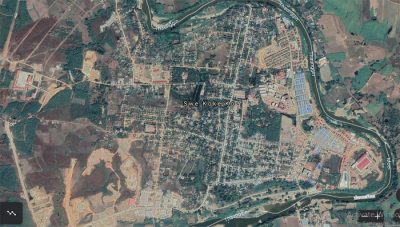Myanmar Government Eyes Town Status for Controversial China-Backed Project

Surveys have been conducted into granting town status to Shwe Kokko Myaing village, a controversial China-backed project in Myawaddy Township, Karen State.
The Moei River village on the Thai border, about 16km north of Myawaddy was once a Democratic Karen Buddhist Army (DKBA) base and now has 10,867 villagers in 1,647 homes.
Work began on the Shwe Kokko new city project in 2017, sparking criticism over its lack of transparency, land confiscations, confusion over the scale of construction, the influx of Chinese money, suspected illicit activity and concerns about the social impact of casinos.
Known as “China Town” or the Shwe Kokko project, the planned new city is reported to be a US$15-billion (19.45-trillion-kyat) collaboration between the Border Guard Force (BGF), a military-backed armed group led by Colonel Saw Chit Thu and formerly known as the DKBA, and a Hong Kong-registered company, Yatai International Holding Group.

A satellite photo of the Shwe Kokko project.
Both Myanmar’s military and government have asked for a suspension of the project after the scale of the construction far exceeded the proposal submitted to the investment authorities.
In 2018, the BGF requested the Karen State government to designate Shwe Kokko Myaing and the 5,260-hectare site as a town. But the state government turned down the request. Shwe Kokko Myaing village covers less than 121 hectares.
“They want to gain town status by combining Shwe Kokko Myaing with other villages. There are forests in the proposed site,” said Myawaddy Township general administrator U Phyo Zaw Ko Ko.
The BGF has submitted a request for town status for more than 590 hectares reaching the Chinese-backed project. Recent land surveys were carried out under the direct supervision of the Karen State administrator.
From rebel camp to town
In 1977-80, the Karen National Union (KNU) established the Kawmoora camp which played an important role for the armed group, both militarily and financially, by the Moei River to the south of Shwe Kokko Myaing. The base housed the KNU’s 101st Special Battalion, a special unit responsible for protecting the group’s leader, General Saw Bo Mya.
The DKBA split from the KNU, and when Myanmar’s military attacked the Kawmoora camp, the DKBA reportedly assisted the government troops.
There were fierce clashes between 1984 and 1995. Many villagers fled to Thailand and the KNU was forced out of Kawmoora.

Shwe Dingar Myaing Hotel at the Shwe Kokko project. / Htet Wai / The Irrawaddy
This followed Col. Saw Chit Thu’s rise in the DKBA. Shwe Kokko Myaing village emerged as the armed group resettled to the north of Kawmoora.
In 2010, 13 battalions, including the one led by Col. Saw Chit Thu, transformed into the BGF. He was appointed general secretary of the border force and Shwe Kokko Myaing became the BGF headquarters.
Chinese-backed new city
The project is a joint venture between Chit Lin Myaing Co run by the BGF and the Yatai group. The Chinese firm is due to put up the capital and the profits are due to be shared with Chit Lin Myaing Co. on a 70-30 basis.
The project is due to feature international-standard hotels, casinos, luxury villas and other entertainment centers.
The government granted a permit for the construction of luxury homes on 10 hectares with an investment of US$22.5 million (30 billion kyats) but the project has already far exceeded the plans.

Construction work at the Shwe Kokko project. / Htet Wai / The Irrawaddy
Villagers asked the government to control the project due to concerns over an influx of Chinese citizens and illicit activities involving the armed group. The United States Institute of Peace also reported that investors have ties to Chinese criminal gangs.
President Office’s spokesman U Zaw Htay said in July that it is difficult to control projects like Shwe Kokko in ethnic areas due to the involvement of armed groups. The government said it will form an investigation committee.
Land surveys were conducted to designate Shwe Kokko Myaing as a town while the central government has reportedly not mentioned violations of investment regulations and the controversial Chinese investment.
Myawaddy residents have alleged that there is a tacit agreement between the government, military and BGF to proceed with the project. They are also concerned that the BGF will have greater authority if the area gains town status.
Others have said the project is the government’s attempt to regain control of the area from the BGF.

Karen State administrators conduct a land survey. / Tay Zar Aung
To gain town status an area must meet 21 criteria, including having a school, hospital, football pitch, garbage dump and cemetery. There must be at least an administration office, police station and agricultural and livestock offices.
U Phyo Zaw Ko Ko said: “Shwe Kokko meets the requirements with almost all the infrastructure. Even Sukali and Wawlei [other towns in Myawaddy Township] are not as lively as Shwe Kokko. It can become a town. It is up to the Union government to decide.”
Lower House lawmaker U Sein Bo for Myawaddy Township said upgrading the village will benefit residents.
“If it becomes a town, there will be an administrative structure. The BGF may have its own responsibilities but it is under the control of the Ministry of Defence. If there is a civilian administration, there will be more division of responsibilities,” said U Sein Bo.
*
Note to readers: please click the share buttons above or below. Forward this article to your email lists. Crosspost on your blog site, internet forums. etc.
Translated from Burmese by Thet Ko Ko

